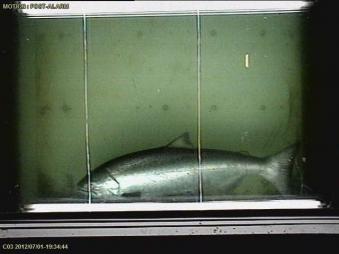Summer- and fall-run chinook were once abundant in the Yakima River Basin, but the runs were decimated as a result of historical land and water development and fisheries management practices. By 1970, the summer-run component was extirpated and the fall-run is maintained by hatchery production using out-of-basin broodstock.
The Yakama Nation began stocking out-of-basin hatchery-reared juvenile fall chinook in the Yakima River at Prosser in the early 1980s; local production of fall chinook began at the Prosser Hatchery in 1997. Currently, fall chinook returning to the Yakima River are a combination of hatchery-origin upriver bright (URB) stock imported as eyed eggs from Little White Salmon Hatchery and progeny of local broodstock captured in the vicinity of Prosser Hatchery. All fall chinook are reared and released as subyearling smolts from the Prosser Hatchery or acclimation sites in the lower Naches or middle Yakima rivers.
The summer-run and URB-stock fall chinook are part of the Upper Columbia River summer/fall chinook Evolutionarily Significant Unit (ESU). In 1998, the National Marine Fisheries Service (NMFS) determined that this ESU did not warrant listing under the Endangered Species Act, but in 2009, the Columbia River Hatchery Scientific Review Group (HSRG) designated the Yakima River fall chinook population as a Contributing population[1].
Two distinct chinook hatchery programs are proposed in the Master Plan:
- A segregated harvest program in the lower Yakima River (below Prosser Dam) that will be closely associated with the Hanford Reach fall chinook population;
- An up-river program (above Prosser Dam) that will be a locally adapting harvest program.
Over time, the latter will be converted to an integrated program if and when natural production improves sufficiently to both maintain natural production and provide fish for broodstock. Both hatchery programs will progress through two distinct phases. During the initial transition phase, the objectives are to re-colonize habitat and to provide harvest. The long-term phase will begin when habitat has improved to the point where natural production is sustainable. During this phase, the purpose of the hatchery will be to contribute to harvest goals.
To address the goal of increasing temporal and spatial diversity as well as expanding the fishery over time, the above-Prosser harvest program will release 500,000 late run (fall) and 500,000 early run (summer) chinook to reaches upstream of Prosser Dam. The late run chinook release will be 100% sub-yearlings while the early run component will release 50% sub-yearlings and 50% yearlings[1]. Early and late run chinook will be reared at Marion Drain and the Prosser Hatchery, respectively (Figure 2-1). Broodstock will come from natural- and hatchery-origin adults produced by the program.
The below-Prosser program will release 1.7 million sub-yearlings (early) below Prosser Dam. Fish will be acclimated in ponds in the lower Yakima River (below RM 10) for about eight weeks prior to their release. This step is designed to ensure that fish return to areas where they can be harvested by tribal fishers and to prevent them from straying above Prosser Dam. Broodstock for this component will come from program hatchery returns and secondarily from Priest Rapids Hatchery.
[1] Yearling summer chinook have been shown to have a 2-3 times higher survival rate than 0-age releases in the Upper Columbia River (RMIS CWT Database, 2011).
Status: Active
10/15/2008 - PresentProject Manager
-
Melinda Davis ,
Fall Chinook Biologist
509-865-5121 ext 6340


